Grundig GWN59650CW washing machine Review
Grundig GWN59650CW washing machine
Great features and premium-machine performance without breaking the bank
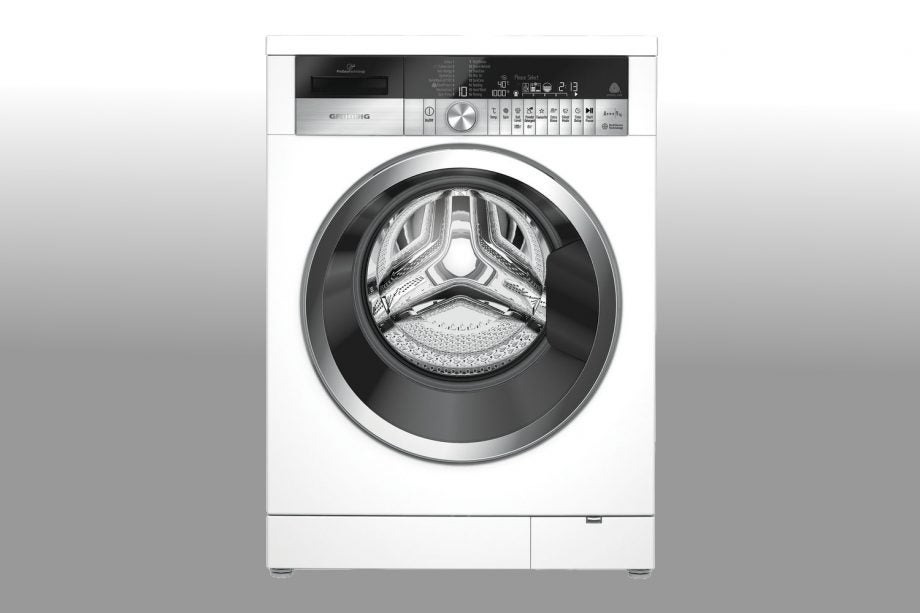
Verdict
Pros
- Excellent wash results
- Low running costs on Eco
- Handy auto-dosing system
- Lots of programmes... and options
- Quiet running
- Solid build quality
Cons
- Touch buttons can be finicky
- Half loads not as Eco
- Not always intuitive
Key Specifications
- Review Price: £699.99
- 9kg/1600 spin
- A+++ energy rating
- 16 programmes
- ProDose auto-dosing
- Multisense technology
- Anti-allergy programme
- 40min Quickwash
What is the Grundig GWN59650CW?
Building on some very good affordable machines this year, Grundig’s GWN59650CW is a top-spec A+++ energy-rated machine with a 1600 spin. Although not exactly cheap, you do get a 9kg capacity machine packed with programmes, options and nice-to-have features.
Well built and turning in excellent cleaning results across all test washes, this Grundig offers seriously frugal running costs, particularly on the Cottons Eco programme. It isn’t quite as economical on other cycles or with smaller loads, and the depth of features will take some learning. Nevertheless, for premium-machine performance without breaking the bank, the GWN59650CW is a great buy.
Grundig GWN59650CW – What’s it like to use?
As befits a model near the top of a brand’s range, the GWN59650CW offers a real features fest. Top of that list is the company’s ProDose technology, allowing you to fill reservoirs in the soap drawer with liquid detergent and fabric conditioner.
The machine automatically detects fabric types, the amount of laundry in the drum and the soil level of the clothes and automatically dispenses the precise amount of liquid detergent and fabric conditioner required. This makes much sense compared to systems that use the same amount of detergent regardless of load size, soiling or materials.
Related: Best washing machines
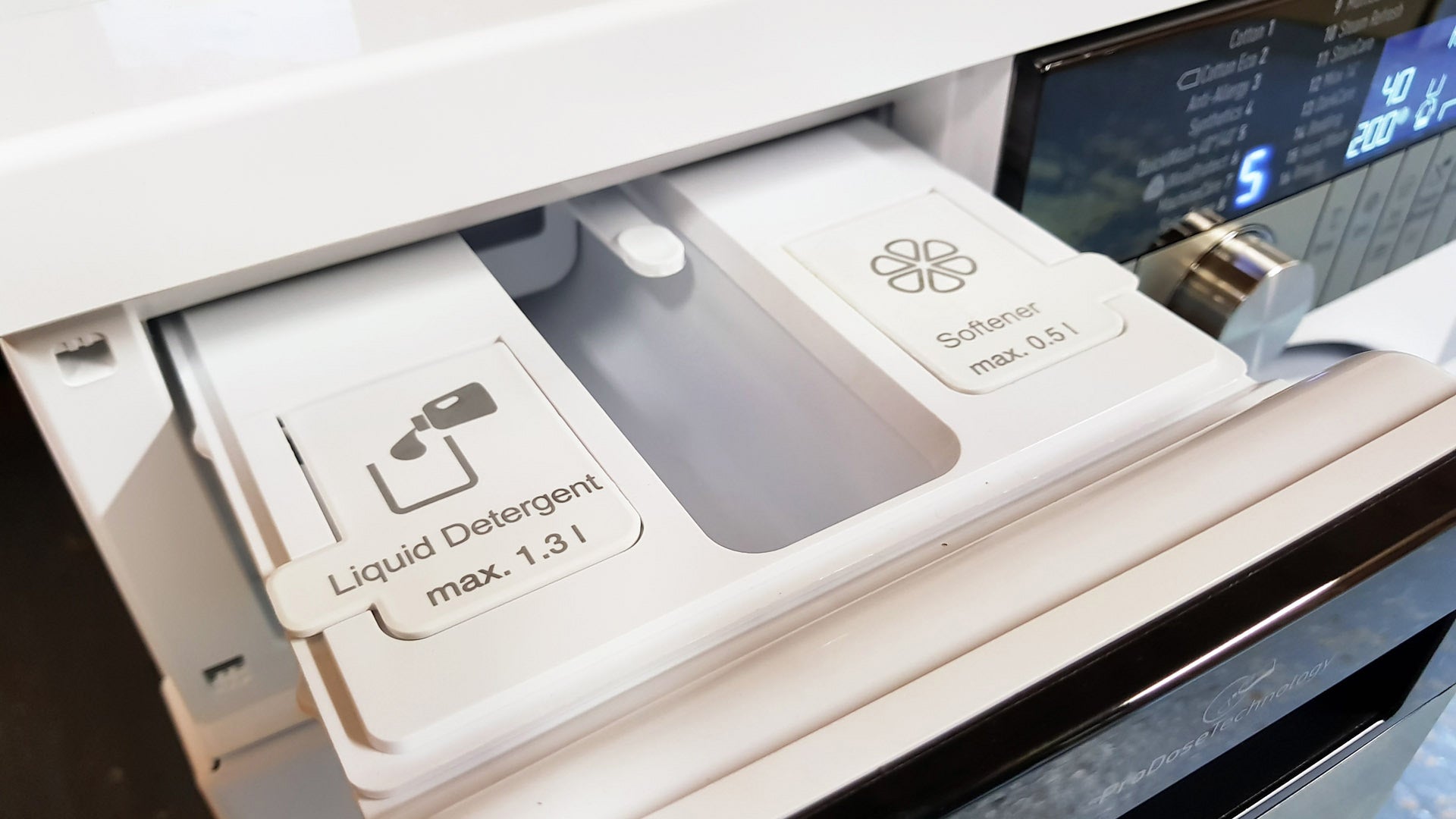
The styling of this washing machine follows that of other recent Grundig machines we’ve tested, being quite severe, sharply lined and bold with starkly contrasting textures. Against the white machine body there are swathes of gloss-black plastic on the upper fascia and door, cool brushed aluminium buttons and drawer trim, and a mirror-chrome ring around the door.
That door is a whopper, too. It opens to reveal a reasonable sized porthole that should swallow a doubled-bed duvet without the need for any foot-based assistance. The opening isn’t quite as big as the door would have you believe, due to a deep cosmetic section at the lower half of the door – but it’s far from tight.
The drum itself is part of Grundig’s Wash System. This is a suite of drum design considerations (drum pattern, paddles, door glass and so on) to wash well while being as smooth and gentle on your clothes as possible. There’s even a MachineCare programme that keeps the drum and tub spotless.
Related: Best dishwashers
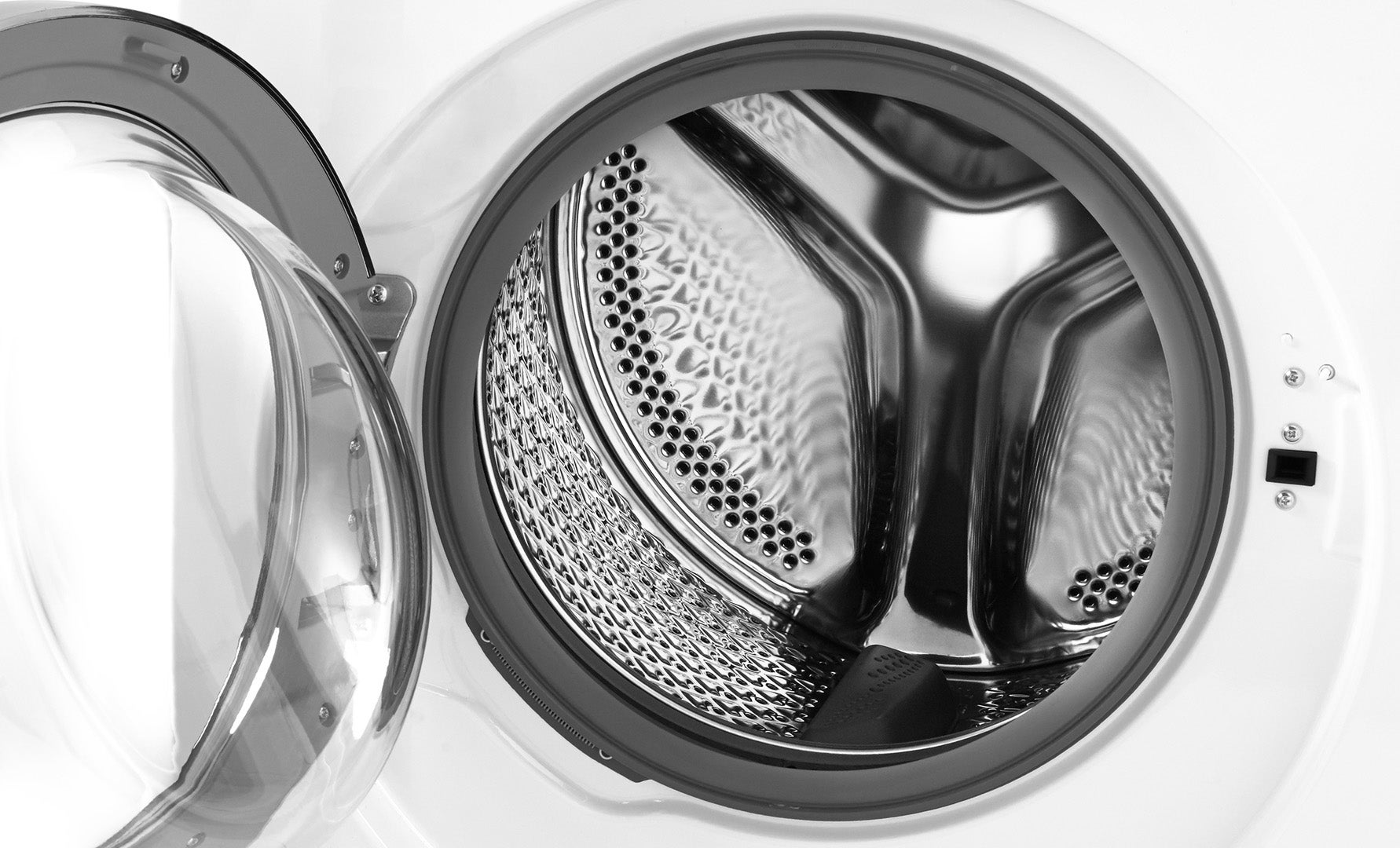
Up at the business area of the fascia, the display is large, sharp and informative. It’s a little more blue-ish in colour than the stock photos show, but it’s certainly easy to read. The central knob rotates freely, indicating the relevant programme with its own numeric display. That small display is very bright, but not as defined as the main display – it’s distinctly fuzzy, in fact.
Options buttons are logical, but we found two minor caveats. They’re touch-sensitive rather the physical ‘click’ buttons, and they weren’t always quick to respond to our first press. Sometimes they responded to a light touch; sometimes we’d find ourselves having to give the buttons a second prod to engage the feature. We found that using the flat pad of your finger print area, rather than just the very tip of the finger, was the way to go.
Second, all that touching and prodding of the brushed metal surface meant that sleek look soon became mucky. The brushed finished collects fingerprints easily and does a good job of hanging onto them for a while when you get the cloth and polish too. Similarly, the black-gloss plastic on the drawer front was showing some greasy palm marks after a few tests. They wiped off far easier, though.
The drawer itself pulls open with ease, revealing the usual trio of receptacles. In this case, the detergent and fabric conditioner areas are reservoirs holding 1.3 litres and 0.5 litres respectively as part of the Grundig’s automatic dosing system. The central divider and a little plastic insert allow you to use liquid or powder detergent in the usual way.
Grundig GWN59650CW – How noisy is it?
If the energy label is to be believed, this Grundig washing machine creates a respectably hushed 50dB of noise when washing, and up to 75dB on its maximum 1600 high-speed spin. It doesn’t; it’s a fair bit quieter, in fact.
In the first ten minutes of the cycle, when it’s measuring and balancing the load, it burbled along at a nicely quiet 47-48dB. That’s typical ambient noise level around the home when you’re having a quiet one-to-one chat. Once stabilised, the wash noise drops to an even quieter 45-46dB through the bulk of the wash.
The spin ramps up in four main stages, with a small pause for a tumble and re-jig of your laundry in between. Noise built up to its 1600 spin maximum of 70dB in our test. That’s the sort of volume at which most people watch TV, so noticeable but not annoying.
That spin noise is comfortably on a par for premium machines at this price, particularly since the GWN59650CW offers such a high-spin speed. If you’re running an old machine with a lot of washing mileage, the Grundig’s 70dB is going to sound like a whisper by comparison.
Grundig GWN59650CW – What programmes does it have?
This machine is billed as a 16-programme model. That’s correct – although we’d argue that the Spin+Pump cycle and MachineCare drum-cleaning programme aren’t really wash programmes.
The 14 remaining programmes cover all the main bases: Cottons, Cottons Eco, Synthetics, DarkCare, Bedding and a fully Woolmark approved Wool Protect wash. For extra care, the auto-dosing system is disabled for the latter Wool Protect cycle, steering you in favour of dedicated wool detergent liquid or powder.
A very gentle Hand Wash programme is included to cover anything that shouldn’t be washed in a washing machine (…er, moving on). The Anti-Allergy programme has a longer heating time, higher selectable temperature and additional rinsing for baby clothes or garments worn close to sensitive skin.
Related: Best vacuums
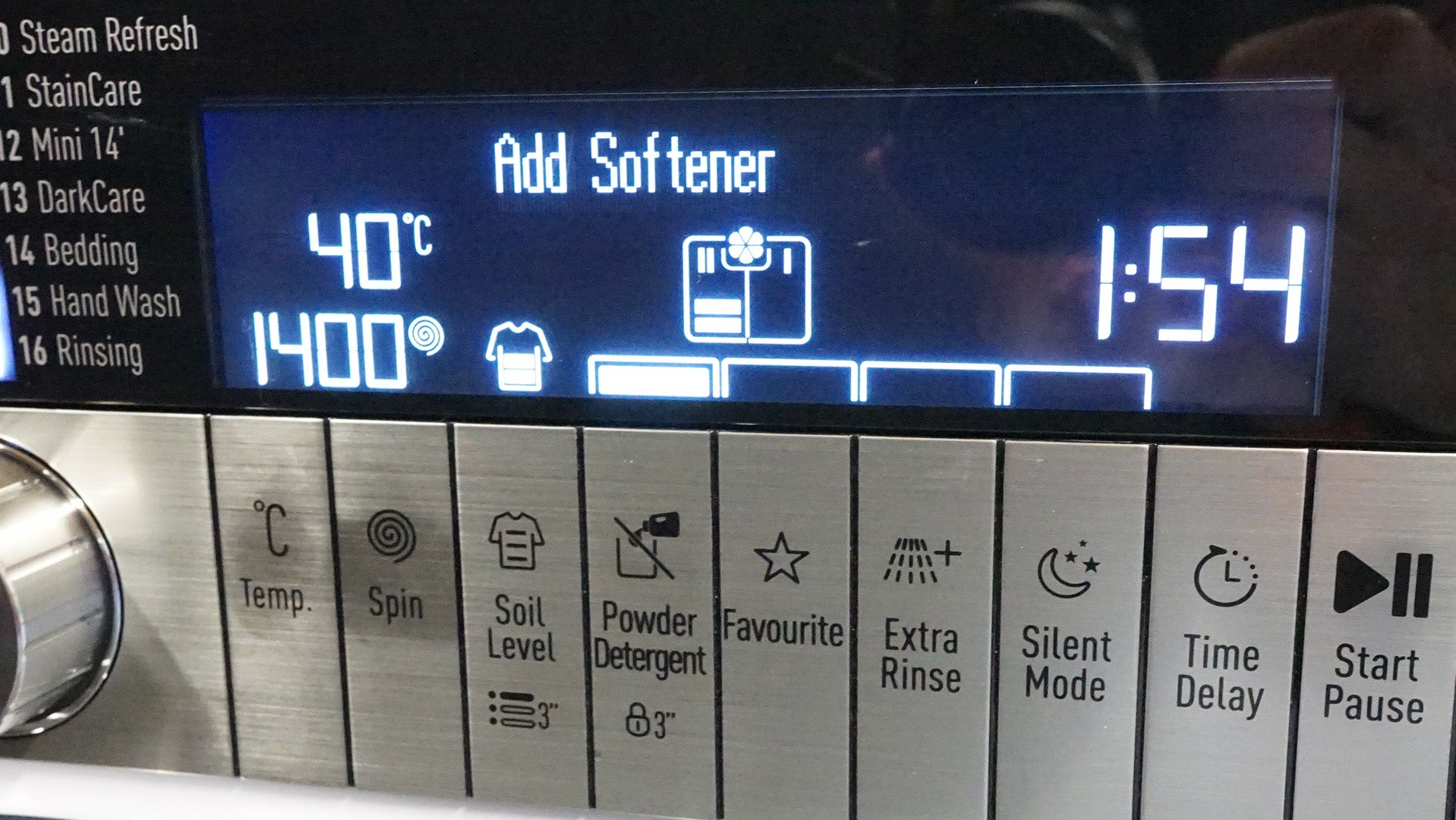
The MultiSense programme is a catch-all for not heavily soiled mixed loads, and you get two high-speed washes. The QuickWash 40 is 40oC programme that takes around 40 minutes; the Mini 14’ programme offers a cool temperature high-speed wash of up to 2kg of clothing in just 14 minutes.
While each programme has a default temperature, most offer a good temperature range that can be selected manually. The same applies to spin speed. While 1600 is the default for the Cotton washes, reducing for more delicate items, most washes offer a user selectable range of spin speeds. Unusually, the same spin speed button is also used for Rinse Hold. That takes a little getting used to.
Also getting two jobs is the Soiling Level button. You choose three levels of soiling for each load and the same button engages the Stain Care selection that runs you through a range of common stains (sweat, mud and so on). While getting your noodle around the dual-use buttons might become obvious over time, we do wonder why a fully sensor-based machine needs you to manually set soiling level in the first place.
More buttons allow you to set up favourite programmes, add an extra rinse and engage a quieter, lower energy Silent Mode. It wasn’t much quieter than the already quiet machine, though. You can set an end time for the wash to finish, pause the wash, or lock the machine controls down with a child-lock feature.
Grundig GWN59650CW – How well does it wash?
That drum is big, but not big enough to take our full load (7.2kg or 80% max capacity) of screwed up cotton clothing. We backed this down to a more sensible 6.2kg to give the washing some breathing and cleaning space. That’s still a large pile of washing.
We ran this main full-load test on both the standard Cottons programme and the Eco Cottons variety to see if there was any difference in wash performance. We’re delighted to say that none was discernible, but the Eco version took a while longer. Some 2hrs 50mins compared to the standard Cotton wash’s 1hr 40mins. By modern A+ and higher-rated eco washing machine standards (we have tested Eco cycles approaching six hours), both of those times are respectably rapid.
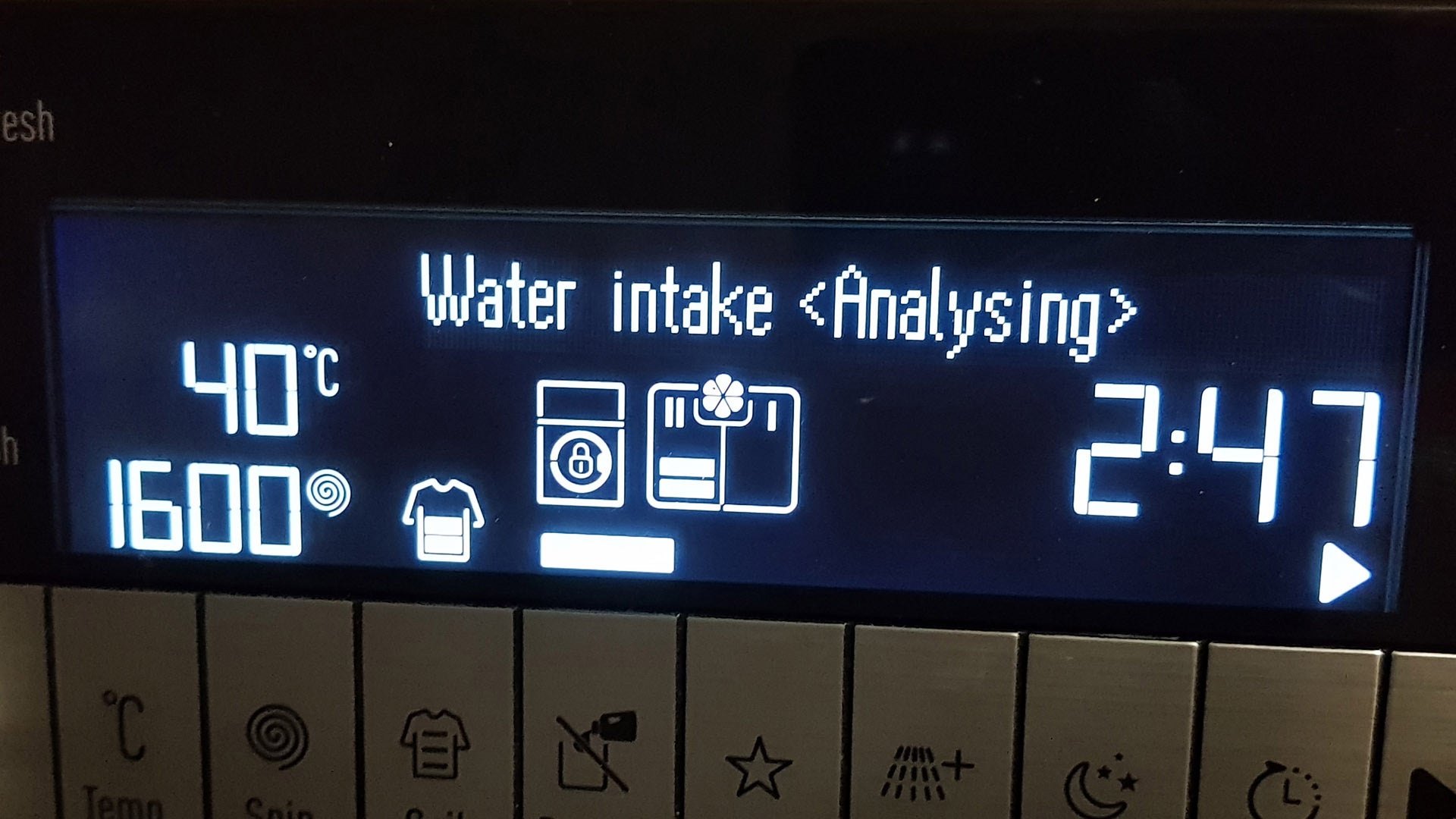
In both main tests, we used our standard stain strip of white cotton marked with blood, coffee, turmeric, ketchup, blackberry juice and engine oil. All the stains were allowed to dry overnight to ensure they were soaked into and stuck fast to the fabric. We set the temperature of each cycle to 40oC, used a non-bio powder (in the middle section of the drawer) and set spin to 1600. We didn’t use any of the Grundig’s stain-specific add-on options to ensure a level playing field with other machines we’ve tested.
Results were stellar on both the Cottons (images shown) and Eco Cottons washes, with barely any difference between results on the two stain strips. All six stains had been well addressed with the blood, coffee, ketchup and tricky blackberry juice removed very effectively.
There was a hint of the turmeric yellow and an engine oil shadow remaining, but only faintly. That’s a great result for a cool-ish (40oC) wash using non-bio powder. Bump up the temperature or use bio detergent and your whites will certainly be whiter than white, as the old TV advert used to say.
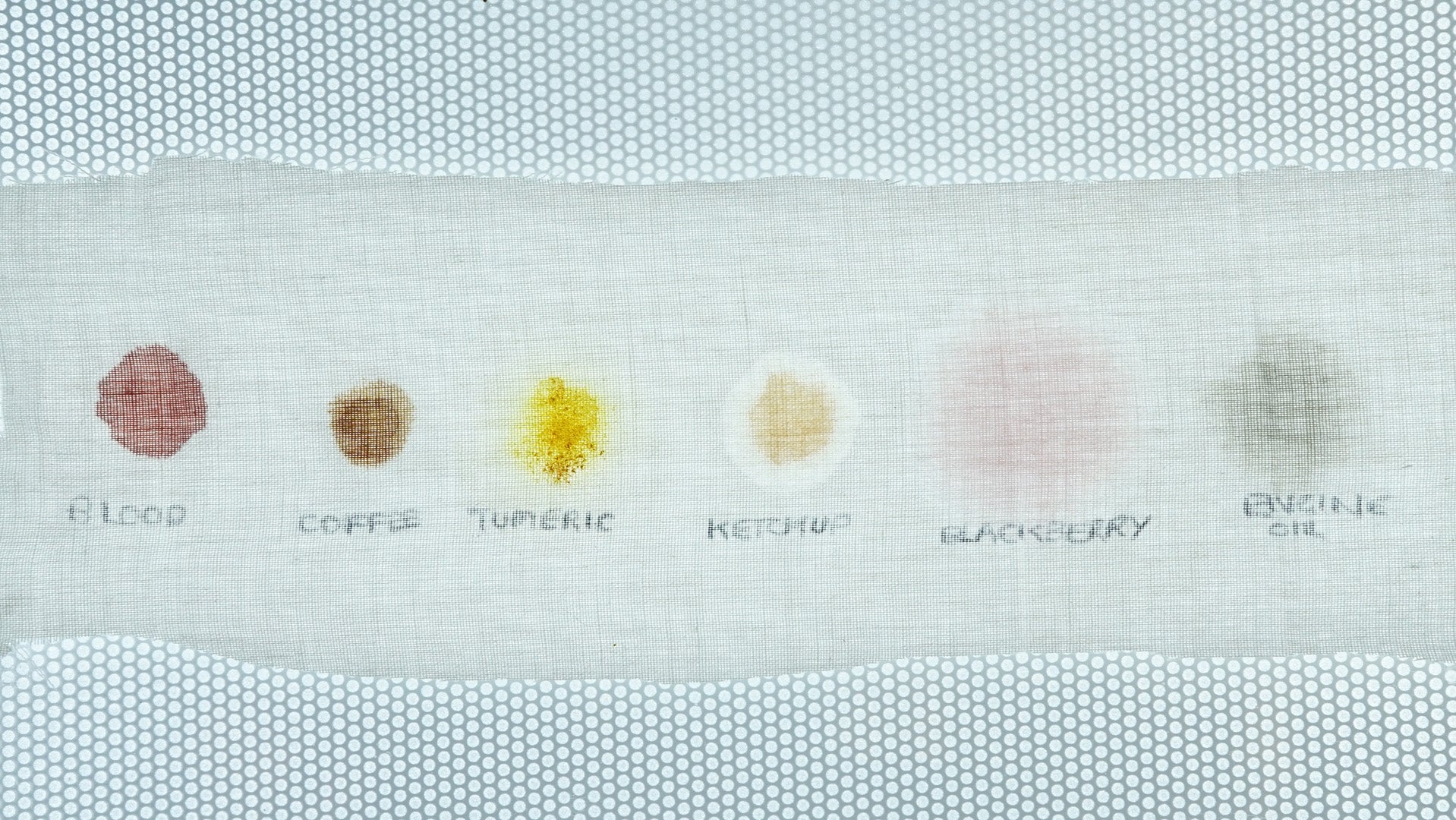
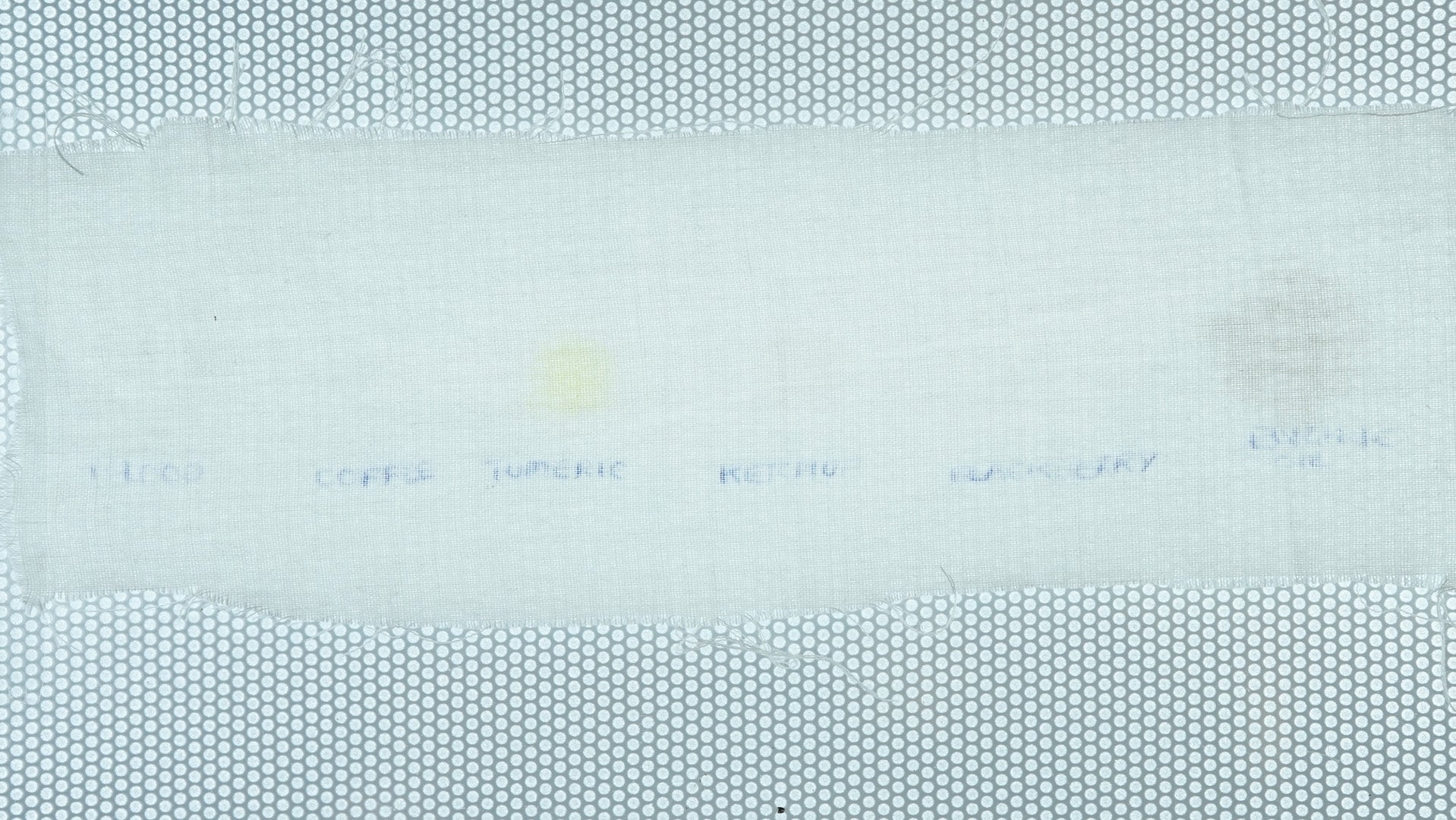
Spin efficiency was good on both counts too, with the Eco Cottons programme actually coming in slightly better at 30.5% of additional water in the finished load, compared to the normal Cottons programme at 33%. This is probably due to the longer cycle time of the Eco wash allowing a bit more natural and spin-powered draining.
Interestingly, on reading the manual once these tests had been done, we noticed that Grundig suggests that the Eco Cottons cycle at 40oC should only be used for loads up to 4.5kg. Ooops. Well, we’re pleased to report that pushing that figure to over 6kg didn’t have any appreciable negative effect on the Grundig’s cleaning ability. Either way, this a great cleaning machine.
Grundig GWN 59650 CW – How much will it cost to run?
Not surprisingly, the main difference between the Cotton and Eco Cottons cycle is energy and water consumption with a full load. Our standard Cotton cycle wash used 0.78kWh for the 6.2kg load, while the Eco version drew just 0.59kWh for the same load. Water consumption on the standard wash was 64.1 litres, while the Eco version took that down to just under 50 litres.
Half loads didn’t see particularly large drops in energy consumption or water usage on either cycle. In both cases, the drop was 15-20% at most for 50% less washing, so bigger loads are the way to go with this Grundig to be super-efficient.
Our TrustedReviews typical UK wash schedule is 240 washes per year, 200 of which would be full loads on Cottons 40 and the other 40 washes would be half loads split evenly between normal Cottons washes and Eco Cottons cycles. That regime was created as Eco programmes were only really useful for lightly soiled clothing (or energy label tests). That’s changing, clearly.
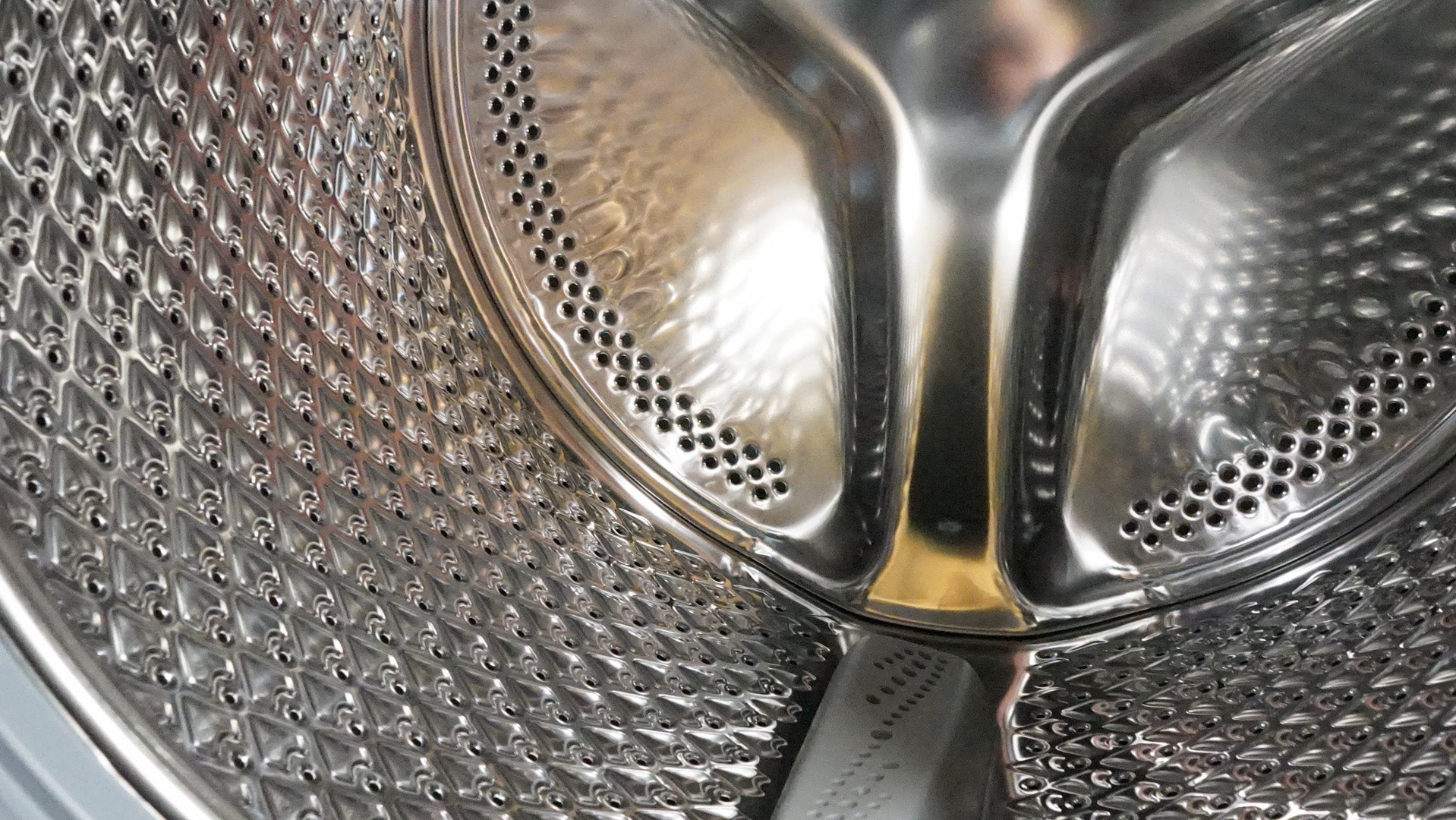
That original regime would use (200 x 0.79kWh) + (20 x 0.75kWh) + (20 x 0.59kWh) = 184.8kWh or £27.72 in electricity costs. For those on metered water it would use (200 x 64.1l) + (20 x 55.0l) + (20 x 39.1l) = 14,700 litres or £51.45 in metered water and waste combined at £3.50 per cubic meter. Grand total: £79.17.
However, let’s ignore the Grundig’s manual for maximum load on Cottons Eco 40 and switch to only using the Cottons Eco programme for the entire year. The cleaning results were well up to the job of day-to-day use, so why not? By the same calculations, electricity usage would drop to approximately 140kWh and water to just over 11,000 litres, bringing our combined annual running cost down to nearer £60. Not too shoddy all.
Those figures are a fraction of what an old machine might use, but probably only just scrape into an A++ rating above an A+. We’ve tested more efficient models working at the top end of the A++ range… but they do come with an asking price a fair bit higher than this Grundig.
Should I buy the Grundig GWN59650CW?
High style with acres of brushed metal, gloss plastic and chrome, Grundig’s GWN59650CV talents are more than skin deep. Great wash performance, good spin efficiency and very frugal running costs on the Eco Cottons programme tick all the major boxes, with the extensive programmes list and auto-dosing nice to have too.
While its operation does take a little getting used to, and isn’t helped by rather insensitive touch controls, for serious performance and a not too high price the Grundig GWN59650CW is difficult to fault.
Verdict
Great wash results, a plethora of features and auto-dosing technology at a relatively sane price make this premium washer a solid buy.
Trusted Score
Key Features
| Drum Capacity | 9kg |
| Energy Rating | A++ |
| Warranty | 5 years |
| Dimensions HxWxD (cm) | 85 x 60 x 61 |
| Approx. Annual Running Cost | 60.00 |
| Approx. Annual Power Consumption (KWh) | 140 |
| Approx. Annual Water Consumption (ltrs) | 11,000 |
Standard Wash: 80% Load
| Power Consumption (KWh) | 0.78 |
| Cost Per Wash at 15p/KWh | 11.7 |
| Water Consumption | 64.1 |
| Time to Completion | 1hr 40mins |
| Noise During Wash (dB) | 48 |
| Noise During Spin (dB) | 70 |
| Moisture After Spin | 33% |
Standard Wash: 40% Load
| Power Used (KWh) | 0.75 |
| Cost of Wash at 15p/KWh | 11.3 |
| Water Use (Litres) | 55.1 |
| Time to Finish | 1hr 40mins |
| Noise During Spin | 70 |
| Noise During Wash | 48 |
| Moisture After Spin (kg) | 31% |
Eco Wash: 40% Load
| Power Per Wash (KWh) | 0.59 |
| Cost Each Wash at 15p/KWh | 8.8 |
| Water Consumption (Litres) | 39.1 |
| Time to End | 2hrs 40mins |
| Noise (Wash Cycle) | 48 |
| Noise (Spin Cycle) | 70 |
| Moisture Post Spin (kg) | 30% |


